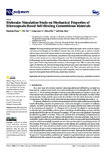Molecular Simulation Study on Mechanical Properties of Microcapsule-Based Self-Healing Cementitious Materials
| dc.contributor.author | Wang, X | |
| dc.contributor.author | Xie, W | |
| dc.contributor.author | Li, Long-yuan | |
| dc.contributor.author | Zhu, J | |
| dc.contributor.author | Xing, F | |
| dc.date.accessioned | 2022-02-25T13:19:55Z | |
| dc.date.issued | 2022-02-04 | |
| dc.identifier.issn | 2073-4360 | |
| dc.identifier.issn | 2073-4360 | |
| dc.identifier.other | 611 | |
| dc.identifier.uri | http://hdl.handle.net/10026.1/18850 | |
| dc.description.abstract |
<jats:p>Microcapsule-based self-healing concrete can effectively repair micro-cracks in concrete and improve the strength and durability of concrete structures. In this paper, in order to study the effect of epoxy resin on the cement matrix at a microscopic level, molecular dynamics were used to simulate the mechanical and interfacial properties of microcapsule-based self-healing concrete in which uniaxial tension was carried out along the z-axis. The radial distribution function, interface binding energy, and hydrogen bonding of the composite were investigated. The results show that the epoxy resin/C-S-H composite has the maximum stress strength when TEPA is used as the curing agent. Furthermore, the interface binding energy between epoxy resin and cement matrix increases with increasing strain before the stress reaches its peak value. The cured epoxy resin can enhance both the interfacial adhesion and the ductility of the composite, which can meet the needs of crack repair of microcapsule-based self-healing cementitious materials.</jats:p> | |
| dc.format.extent | 611-611 | |
| dc.format.medium | Electronic | |
| dc.language | en | |
| dc.language.iso | en | |
| dc.publisher | MDPI | |
| dc.subject | cementitious material | |
| dc.subject | mechanical property | |
| dc.subject | microcapsule | |
| dc.subject | molecular dynamics | |
| dc.subject | self-healing | |
| dc.title | Molecular Simulation Study on Mechanical Properties of Microcapsule-Based Self-Healing Cementitious Materials | |
| dc.type | journal-article | |
| dc.type | Journal Article | |
| plymouth.author-url | https://www.ncbi.nlm.nih.gov/pubmed/35160600 | |
| plymouth.issue | 3 | |
| plymouth.volume | 14 | |
| plymouth.publication-status | Published online | |
| plymouth.journal | Polymers | |
| dc.identifier.doi | 10.3390/polym14030611 | |
| plymouth.organisational-group | /Plymouth | |
| plymouth.organisational-group | /Plymouth/Faculty of Science and Engineering | |
| plymouth.organisational-group | /Plymouth/Faculty of Science and Engineering/School of Engineering, Computing and Mathematics | |
| plymouth.organisational-group | /Plymouth/REF 2021 Researchers by UoA | |
| plymouth.organisational-group | /Plymouth/REF 2021 Researchers by UoA/UoA12 Engineering | |
| plymouth.organisational-group | /Plymouth/Research Groups | |
| plymouth.organisational-group | /Plymouth/Research Groups/Marine Institute | |
| plymouth.organisational-group | /Plymouth/Users by role | |
| plymouth.organisational-group | /Plymouth/Users by role/Academics | |
| dc.publisher.place | Switzerland | |
| dcterms.dateAccepted | 2022-02-03 | |
| dc.rights.embargodate | 2022-2-26 | |
| dc.identifier.eissn | 2073-4360 | |
| dc.rights.embargoperiod | Not known | |
| rioxxterms.versionofrecord | 10.3390/polym14030611 | |
| rioxxterms.licenseref.uri | http://www.rioxx.net/licenses/all-rights-reserved | |
| rioxxterms.licenseref.startdate | 2022-02-04 | |
| rioxxterms.type | Journal Article/Review |


